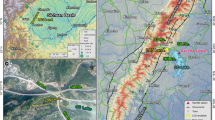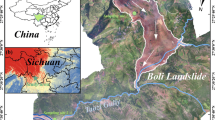Abstract
On May 12, 2019, a landslide occurred near a construction site of a reservoir dam along the left bank of the Wulong River, Qinghai Province, China. Video footage showed that the entire failure process of the landslide lasted for 15 min. Although an excavator that parked on the foundation pit was buried and the Wulong River was blocked, this landslide did not cause any casualties. Based on field investigations, 3D laser scanning, unmanned aerial vehicle observations, and borehole surveys, this study aims to reveal the cause and initiation mechanisms of the landslide. The landslide developed on a typical dip slope with thick-bedded conglomerates intercalated with a few mudstone layers. The slide mass mainly consisted of conglomerates with a dip angle varying from 20 to 40°, failing along bedding plane contacts with the underlying muddy intercalation. Numerous tension cracks had developed in the upper part of the slope due to stress relaxation during the process of bank slope evolution associated with rapid river incision. These cracks damaged the integrity of the rock mass and promoted rapid rainfall infiltration. The water infiltrated into the slope and deteriorated the mechanical properties of the rock mass, which resulted in long-term deterioration of the slope stability conditions. In addition, the temperature of Tongren County was below zero for 5 months in a year, hence the freeze–thaw cycle of the water filled in the cracks would have reduced the shear strength further. There were 10 days of continuous rainfall before the landslide occurred, and the cumulative precipitation in 2018 and 2019 was also significantly more than that of previous years. Three primary factors are involved in the landslide event: (1) thick-bedded conglomerates intercalated with a few mudstone layers with contrasts in strength, (2) development of numerous relaxation cracks, and (3) long-term rainfall accumulation.




















Similar content being viewed by others
References
Christaras B (1997) Landslides in iliolitic and marly formations. Examples from north-western Greece. Eng Geol 47(1–2):57–69
Cevik SY, Ulusay R (2005) Engineering geological assessments of the repeated plane shear slope instability threatening Babadag (Turkey) and its environmental impacts. Environ Geol 47(5):685–701
Deere DU, Patton FD (1971) Slope stability in residual soils. Proceedings of the Fourth Panamerican Conference on Soil Mechanics and Foundation Engineering, San Juan, Puerto Rico, pp. 87–170
Eisbacher GH, Clague JJ (1984) Destructive mass movements in high mountains: hazard and mitigation. Paper – Geological Survey of Canada, vol 84-16. Geological Survey of Canada, Ottawa, p 230
Eberhardt E, Thuro K, Luginbuehl M (2005) Slope instability mechanisms in dipping interbedded conglomerates and weathered marls—the 1999 Rufi landslide, Switzerland. Eng Geol 77(1–2):35–56
Guo XH (2017) Relationship between landslide-dammed lakes with the evolution of upper stream of the Yellow River from Longyang Gorge to Liujia Gorge on northeast margin of Tibet Plateau. PhD thesis dissertation, Chang’an University, Xi’an, China (In Chinese with English abstract)
Heim A (1932) Bergsturz und Menschenleben. Fretz and Wasmuth, Verlag, 218 pp
Hutchinson JN, Somerville SH, Petley DJ (1973) A landslide in periglacially disturbed Etruria marl at Bury Hill, Staffordshire. Q J Eng Geol Hydrogeol 6:377–404
Huang RQ, Lin F, Chen DJ et al (2001) Formation mechanism of unloading fracture zone of high slopes and its engineering behaviors. J Eng Geol 9(3):227–232 (In Chinese)
Huang RQ, Wang ST, Zhang ZY et al (2002) Epigenetical process of the earth crust in Southwest China and engineering environmental effects. Sichuan University Press, Chengdu (in Chinese)
Huang RQ (2008) Geodynamical process and stability control of high rock slope development. Chin J Rock Mech Eng 27(8):1525–1544 (in Chinese)
Maquaire O, Malet J-P, Remaıtre A, Locat J, Klotz S, Guillon J (2003) Instability conditions of marly hill slopes: towards landsliding or gullying? The case of the Barcelonnette basin, south east France. Eng Geol 70:109–130
Miščević P, Števanić D, Štambuk-Cvitanović N (2009) Slope instability mechanisms in dipping conglomerates over weathered marls: Bol landslide, Croatia. Environ Geol 56(7):1417–1426
Miao HB, Wang GH, Yin KL, Kamai T, Li Y (2014) Mechanism of the slow-moving landslides in Jurassic red-strata in the Three Gorges Reservoir, China. Eng Geol 171:59–69
Rahardjo H, Lee TT, Leong EC (2005) Response of a residual soil slope to rainfall. Can Geotech J 42:340–351
Taylor RK, Cripps JC (1987) Weathering effects: slopes in mudrocks and over consolidated clays. In: Anderson MG, Richards KS (eds) Slope stability: geotechnical engineering and geomorphology. Wiley, New York, pp 405–445
Wu H, Ma H, Hu D (2010) Geological analysis and model experimental study of deformation mechanism of ditch-Moore red bed landslide at Qinghai plateau. Chin J Rock Mech Eng 29:2091–2102 (in Chinese)
Xu ZL, Luo MS, Zhang KX et al (2013) Cenozoic sedimentation rate of Xunhua, Linxia and guide basins responding to the uplift of the Tibetan Plateau. Geolog Bull China 32(1):93–104 (In Chinese with English abstract)
Yan GQ, Yin YP, Huang BL, Zhang Z, Zhu S (2019) Formation mechanism and characteristics of the Jinjiling landslide in Wushan in the Three Gorges Reservoir region, China. Landslides 16(11):2087–2101
Yue ZQ, Lee CF (2002) A plane slide that occurred during construction of a national expressway in Chongqing, SW China. Q J Eng Geol Hydrogeol 35:309–316
Yang H, Wei F, Ma Z, Guo H, Su P, Zhang S (2020) Rainfall threshold for landslide activity in Dazhou, Southwest China. Landslides 17(1):61–77
Zhang S, Xu Q, Hu Z (2016) Effects of rainwater softening on red mudstone of deep-seated landslide, Southwest China. Eng Geol 204:1–13
Zheng Y, Chen CX, Liu TT, Zhang W, Song Y (2018) Slope failure mechanisms in dipping interbedded sandstone and mudstone revealed by model testing and distinct-element analysis. Bull Eng Geol Environ 77(1):49–68
Acknowledgments
The authors thank the Qinghai Water Resources and Hydroelectric Investigation & Design Institute for very useful photos, and Chief Engineer Guanghong Ju, Engineer Weiqiang Yang, Qiufeng Feng for exploration work. We also thank Dr. Xin Wang for editing the English of the manuscript and thank the Editor and the reviewer for their comments which greatly improved the quality of the manuscript.
Funding
This study has been supported by the National Natural Science Foundation of China (41907246).
Author information
Authors and Affiliations
Corresponding author
Rights and permissions
About this article
Cite this article
Xia, M., Ren, G.M. & Yang, X.L. Mechanism of a catastrophic landslide occurred on May 12, 2019, Qinghai Province, China. Landslides 18, 707–720 (2021). https://doi.org/10.1007/s10346-020-01559-4
Received:
Accepted:
Published:
Issue Date:
DOI: https://doi.org/10.1007/s10346-020-01559-4




